The most profound digital transformation lessons often come from unexpected sources. When Netflix embarked on their cloud migration in 2010, they anticipated challenges with content delivery, data migration, and application modernization. What they discovered was more fundamental: their identity architecture would become more critical to their digital strategy than their content delivery network.
This revelation has become the defining challenge for every modern enterprise. While organizations invest billions in digital transformation initiatives—cloud adoption, AI integration, customer experience platforms—most are building these capabilities on identity foundations designed for a simpler, perimeter-based world.
The Identity-Digital Strategy Convergence
Modern enterprises operate in a complexity that traditional identity models never anticipated:
- Multi-Cloud Environments: Organizations manage 130+ applications across AWS, Azure, Google Cloud, and hybrid infrastructures
- AI Agent Integration: Autonomous systems that require dynamic, contextual permissions beyond traditional user models
- Partner Ecosystem Expansion: B2B collaborations requiring seamless access without compromising security
- Real-Time Customer Experiences: Digital services that demand instant onboarding and frictionless interactions
Yet research reveals that 73% of organizations still rely on identity architectures designed for single-domain, on-premises environments. This architectural mismatch creates a digital transformation bottleneck that constrains every strategic initiative.
The Strategic Identity Architecture Framework
Organizations successfully navigating this transformation recognize three fundamental principles that transform identity from operational overhead to strategic enabler:
1. Business Velocity as Core Design Principle
Strategic identity architecture accelerates business processes rather than gating them. This requires:
Just-in-Time Access Architecture: Eliminating standing privileges while maintaining operational velocity through automated provisioning and deprovisioning workflows. A Fortune 500 financial services firm implemented JIT access and transformed their new account opening process from 3 days to 4 hours.
Zero-Friction Onboarding Systems: New employees, partners, and customers gain appropriate access within minutes through automated verification and role assignment based on verified attributes and business context.
Collaborative Access Enablement: Cross-functional teams and external partnerships operate without identity barriers through dynamic permission models that adapt to business relationships and project requirements.
2. Adaptive Security Through Contextual Intelligence
Modern threats require identity systems that make real-time security decisions based on comprehensive context analysis:
Continuous Risk Assessment: Every access request evaluated against current threat landscape, user behavior patterns, and environmental factors using machine learning algorithms that adapt to emerging risks.
Contextual Authorization Models: Moving beyond simple "who has access" to comprehensive evaluation including temporal factors, location context, device posture, and business justification.
Automated Threat Response: Identity architectures that can instantly revoke access, require additional authentication, or limit permissions based on detected anomalies without disrupting legitimate business operations.
3. Future-Ready Architecture Design
The most strategic identity investments prepare organizations for capabilities they don't yet need but will soon require:
AI Agent Identity Management: Frameworks that handle autonomous systems requiring dynamic permissions that adapt based on agent behavior, task complexity, and risk assessment.
Quantum-Safe Cryptographic Integration: Architecture designed to accommodate post-quantum security standards without requiring complete system replacement.
Edge Computing Optimization: Identity decisions that work at millisecond response times across distributed computing environments where centralized authentication becomes impractical.
Implementation Strategy: From Concept to Reality
Understanding strategic identity principles requires translation into practical implementation. Organizations successfully making this transition follow a proven modernization approach:
Leading organizations converge multiple identity functions into unified platforms rather than managing separate silos:
- Unified Identity Governance: Single platform handling employee lifecycle, access certifications, and compliance reporting
- Integrated Privileged Access: Just-in-time privileged access management within the same system handling standard user provisioning
- Customer Identity Inclusion: B2B and B2C identity management integrated with internal systems for seamless partner collaboration
This convergence eliminates integration complexity while delivering proven operational benefits like 95% faster provisioning and measurable cost savings.
Phase 2: Policy Architecture Modernization
Replacing static role-based models with dynamic, context-aware authorization:
Hybrid Authorization Implementation: Combining role-based access control for stable organizational structures with attribute-based access control for dynamic business requirements.
Relationship-Based Access Control: Managing permissions based on business relationships, organizational context, and data sensitivity rather than predetermined role assignments.
Progressive Trust Systems: Identity architectures that adapt permission levels based on demonstrated behavior, verification depth, and risk context.
Phase 3: Intelligent Automation Integration
The final phase involves AI and machine learning capabilities that make identity architecture truly strategic:
Predictive Access Management: Systems that anticipate access needs based on project assignments, seasonal business patterns, and organizational changes.
Automated Compliance Orchestration: Identity platforms that continuously maintain regulatory compliance without manual intervention through policy automation and continuous monitoring.
Risk-Adaptive Security Controls: Real-time adjustment of security policies based on threat intelligence, behavioral analytics, and business context.
Measuring Strategic Success
Organizations treating identity as digital strategy infrastructure measure success through business impact rather than traditional IT metrics:
Strategic Identity Metrics:
- Digital transformation project acceleration
- New revenue stream enablement capability
- Customer and partner onboarding velocity
- Cross-cloud application deployment speed
- AI initiative time-to-value achievement
A healthcare network achieved 99.9% uptime and 88% faster clinician onboarding through identity architecture modernization—not through hardware upgrades, but through elimination of identity integration delays that previously constrained system access.
The Competitive Advantage Opportunity
The enterprises that will dominate the next decade are already making this strategic shift. They're building identity architectures that don't just support digital transformation—they enable it, accelerate it, and ultimately become a source of competitive advantage.
This transformation requires more than technology updates. It demands recognition that identity architecture has become as critical to business strategy as network infrastructure, data architecture, and application platforms.
The question isn't whether your identity architecture will become part of your digital strategy—it's whether you'll lead this transformation or be forced to follow when competitive pressure makes the shift inevitable.










